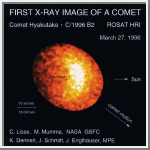|
COMETS EARTH JUPITER KUIPER BELT MARS MERCURY METEORITES NEPTUNE OORT CLOUD PLUTO SATURN SOLAR SYSTEM SPACE SUN URANUS VENUS ORDER PRINTS
PHOTO CATEGORIES SCIENCEVIEWS AMERICAN INDIAN AMPHIBIANS BIRDS BUGS FINE ART FOSSILS THE ISLANDS HISTORICAL PHOTOS MAMMALS OTHER PARKS PLANTS RELIGIOUS REPTILES SCIENCEVIEWS PRINTS
|
Related Document
Download Options
A team of U.S. and German astrophysicists have made the first ever detection of X-rays coming from a comet. The discovery of a strong radiation signal -- about 100 times brighter than even the most optimistic predictions -- was made March 27, 1996, during observations of comet Hyakutake using Germany's orbiting ROSAT satellite. "It was a thrilling moment when the X-rays from the comet appeared on our screen at the ROSAT ground station," said Dr. Konrad Dennerl of the Max Planck Institute for Extraterrestrial Physics (MPE), Garching, Germany. Following the initial detection, the team reported repeated X-ray emissions from the comet over the next 24 hours. The comet was near its closest approach to the Earth at a distance of less than 10 million miles when it was first detected by ROSAT. The strength and rapid changes in intensity of the comet's X-ray emission both surprised and puzzled astronomers. "We had no clear expectation that comets shine in X-rays," said Dr. Michael J. Mumma of NASA's Goddard Space Flight Center, Greenbelt, MD. "Now we have our work cut out for us in explaining these data, but that's the kind of problem you love to have." The comet was examined repeatedly during March 26-27 as it swept across the sky. The German scientists used a computer to correct for the comet's motion to produce accurate images during each observation. X-rays have never been found from a comet before, and scientists had optimistically predicted an intensity that turned out to be about 100 times weaker than the radiation actually detected by ROSAT. Strong changes in the brightness of the X-rays were another surprise. There were pronounced increases and decreases in the X-ray brightness from one ROSAT observation to another, typically over a time difference of a few hours. Still another puzzle is the nature of the physical process that generates the X-rays, but the ROSAT image may contain clues to this process. In the image, the X-rays from the comet seem to come from a crescent-shaped region on the sunward side of Comet Hyakutake. Explaining the unexpected bright X-ray emission is the next major task for the science team. One preliminary theory is that X-ray emission from the Sun was absorbed by a cloud of gaseous water molecules surrounding the nucleus of the comet, and then were re-emitted by the molecules in a process physicists call "fluorescence." According to this idea, the cloud is so thick that its sunward side absorbs nearly all the incoming solar X-rays, so that none reach the remainder of the cloud. This could explain why the cometary X-ray emission has the form of a crescent, rather than that of a sphere around the nucleus. A second possible explanation is that the X-rays are produced from the violent collision between the comet material and the supersonic "wind" of plasma and particles streaming away from the Sun. "We always learn something new when we study an object at different wavelengths," commented Dr. Carey M. Lisse of Goddard, the leader of the X-ray investigation. "Now we have to determine why the comet is so bright in X-rays, and see what we can learn about its structure and composition from these unique images."
Don Savage Headquarters, Washington, DC April 4, 1996 (Phone: 202/358-1547) Jim Sahli Goddard Space Flight Center, Greenbelt, MD (Phone: 301/286-0697) |
